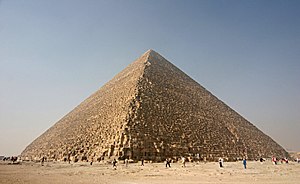History:
The Great Pyramid of Giza
is a remarkable architectural achievement. Despite
its age (well over 4000 years old), it still stands and
is the only remaining of the seven wonders of the world.
It is 481 ft tall and weighs an estimated 6.5 million
tonnes 1.
The Great Pyramid is believed to have been built during the reign of pharaoh Khufu. It was built to serve as the burial place for the pharaoh for religious purposes to protect his spirit in the afterlife. It is believed to have been built around 2500 BCE. At this time the Egyptians did not have access to many of the tools and tricks of engineering that we use today to carry out massive architectural projects. They did not have iron tools, precise measuring equipment, or even wheels. So, how were they ever able to construct such a massive monolith?
Two key hurdles would have had to have been overcome during construction:
- Transporting the
massive stone blocks used to construct the pyramid to
the construction site
- Raising the blocks to their final heights within the pyramid
In the pages on this
website we'll take a look at several different methods
the Egyptians may have used to overcome some of these
construction obstacles, using simple tricks of physics
and engineering.
